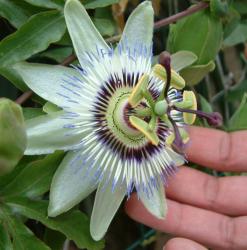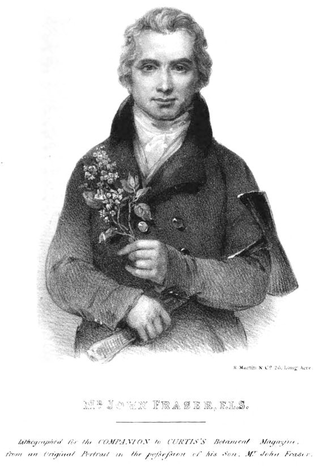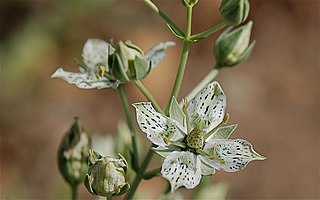
Gentiana acaulis, the stemless gentian, or trumpet gentian, is a species of flowering plant in the family Gentianaceae, native to central and southern Europe, from Spain east to the Balkans, growing especially in mountainous regions, such as the Alps and Pyrenees, at heights of 800–3,000 m (2,625–9,843 ft).

Convolvulaceae, commonly called the bindweeds or morning glories, is a family of about 60 genera and more than 1,650 species. These species are primarily herbaceous vines, but also include trees, shrubs and herbs. The tubers of several species are edible, the best known of which is the sweet potato.

Senecio is a genus of flowering plants in the daisy family (Asteraceae) that includes ragworts and groundsels.

The Scrophulariaceae are a family of flowering plants, commonly known as the figwort family. The plants are annual and perennial herbs, as well as shrubs. Flowers have bilateral (zygomorphic) or rarely radial (actinomorphic) symmetry. The Scrophulariaceae have a cosmopolitan distribution, with the majority found in temperate areas, including tropical mountains. The family name is based on the name of the included genus Scrophularia L.

The Passifloraceae are a family of flowering plants, containing about 750 species classified in around 27 genera.

Gentianaceae is a family of flowering plants of 103 genera and about 1600 species.

Knightia is a small genus of the family Proteaceae endemic to New Zealand, named in honor of Thomas Andrew Knight. One extant species, K. excelsa (rewarewa) is found in New Zealand. Two further Knightia species are found in New Caledonia, although they were placed in the genus Eucarpha by Lawrie Johnson and Barbara Briggs in their influential 1975 monograph "On the Proteaceae: the evolution and classification of a southern family", a placement supported in a 2006 classification of the Proteaceae. A fossil species from upper Miocene deposits in Kaikorai has been described as Knightia oblonga. Knightia has been placed in the tribe Roupaleae of the subfamily Grevilleoideae.

Amorpha is a genus of plants in the pea family, Fabaceae. All the species are native to North America, from southern Canada, most of the United States (US), and northern Mexico. They are commonly known as false indigo. The name Amorpha means "deformed" or "without form" in Greek and was given because flowers of this genus only have one petal, unlike the usual "pea-shaped" flowers of the Faboideae subfamily. Amorpha is missing the wing and keel petals.

Dipteryx is a genus containing a number of species of large trees and possibly shrubs. It belongs to the "papilionoid" subfamily – Faboideae – of the family Fabaceae. This genus is native to South and Central America and the Caribbean. Formerly, the related genus Taralea was included in Dipteryx.

Brahea is a genus of palms in the family Arecaceae. They are commonly referred to as hesper palms and are endemic to Mexico and Central America. All Hesper Palms have large, fan-shaped leaves. The generic name honours Danish astronomer Tycho Brahe (1546-1601).

Swertia is a genus in the gentian family containing plants sometimes referred to as the felworts. Some species bear very showy purple and blue flowers. Many members of this genus have medicinal and cultural purposes.

Brachyglottis is a genus of flowering plants in the family Asteraceae. The genus was erected on November 29, 1775, by Johann Reinhold Forster and Georg Forster. The name was derived from the Greek brachus ("short") and glottis a reference to the size of the ray florets.

Matelea is a genus of flowering plants in the family Apocynaceae. It contains about 200 species, which are commonly known as milkvines. Some people consider Chthamalia to be a synonym to or a subgenus of Matelea.

John Fraser, FLS, F.R.H.S., was a Scottish botanist who collected plant specimens around the world, from North America and the West Indies to Russia and points between, with his primary career activity from 1780 to 1810. Fraser was a commissioned plant collector for Catherine, Czar of Russia in 1795, Paul I of Russia in 1798, and for the Dowager Empress Maria Feodorovna in 1806; he issued nursery catalogues c. 1790 - 1796, and had an important herbarium that was eventually sold to the Linnean Society.

Barklya is a genus of Australian trees in the legume family, Fabaceae. It belongs to the subfamily Cercidoideae. The sole species is Barklya syringifolia, commonly known as golden crown or golden glory. It grows in rainforest to 20 metres tall. Recorded from Queensland and New South Wales in rain forest. It is often used as an ornamental.

Rivina is a genus of flowering plants in the family Petiveriaceae. The name honors German botanist Augustus Quirinus Rivinus (1652-1723).

Frasera albomarginata is a species of flowering plant in the gentian family known by the common name desert green gentian, or desert frasera.

Frasera parryi is a species of flowering plant in the gentian family known by the common name Coahuila frasera.
Frasera tubulosa is a species of flowering plant in the gentian family known by the common name Kern frasera.

Frasera caroliniensis, commonly known as American columbo or yellow gentian, is a herbaceous perennial of the gentian family Gentianaceae found in the deciduous forest of Southern Ontario and throughout the eastern and southeastern United States. It was previously known as Swertia caroliniensis.



















